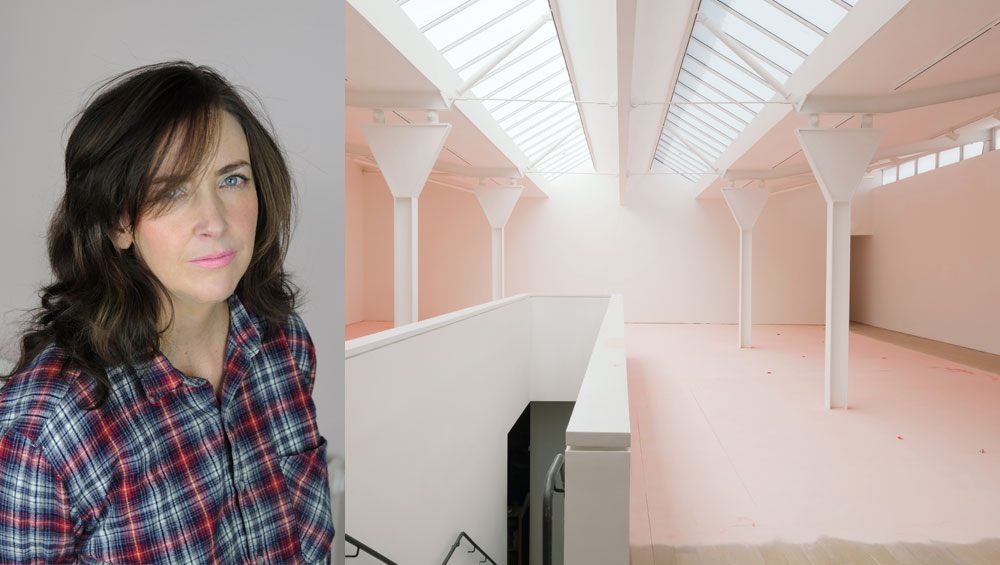
Karla Black, Photo: Ronnie Black, Courtesy Galerie Gisela Capitain, Cologne; Karla Black: Sculptures (2001-2021) – Details for a Retrospective, installation view, Fruitmarket gallery. Courtesy Galerie Gisela Capitain, Cologne and Modern Art, London. Photo: Tom Nolan.
by VERONICA SIMPSON
A great sugary dune of pink powder spills across the upper floor of Edinburgh’s Fruitmarket gallery, its edges blurring in the pale, intoxicating, pastel expanse, transforming the white gallery walls as sun and clouds pass over the large lightwell. It is a signature Karla Black colour and a signature move – to make you question your sense of your own physical (and emotional) self in that space, in relation to the work.
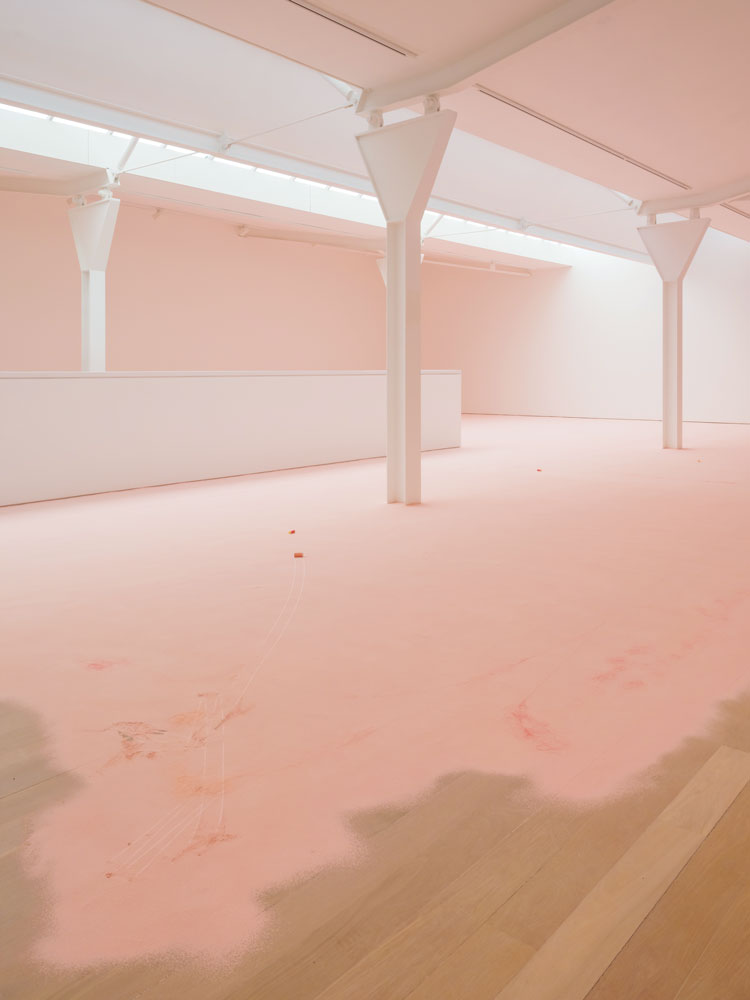
Karla Black. Punctuation is pretty popular: nobody wants to admit to much, (detail), 2008/2021. Plaster powder, powder paint, thread. Courtesy Galerie Gisela Capitain, Cologne and Modern Art, London.
Photo: Tom Nolan.
Black (b1972, Alexandria, Scotland), who represented Scotland in 2011 at the Venice Art Biennale, said in an interview at the time: “People ask: what is the meaning of this sculpture? I don’t understand that question and I’m not remotely interested. Rather than having a meaning it has a function. Rather than having an ephemeral relationship to language outside of itself, I’d rather ask: what are the consequences of this sculpture, how does it function in the world, how does it operate, what does it do?”
While that statement might come across as reductive, her work is anything but. It is a celebration of material, of texture, of the sheer physical, haptic wonder of the human senses and the world around us, abandoning hierarchies of fine art and everyday materials in the joyful, playful chaos of collage in unexpected forms and places.
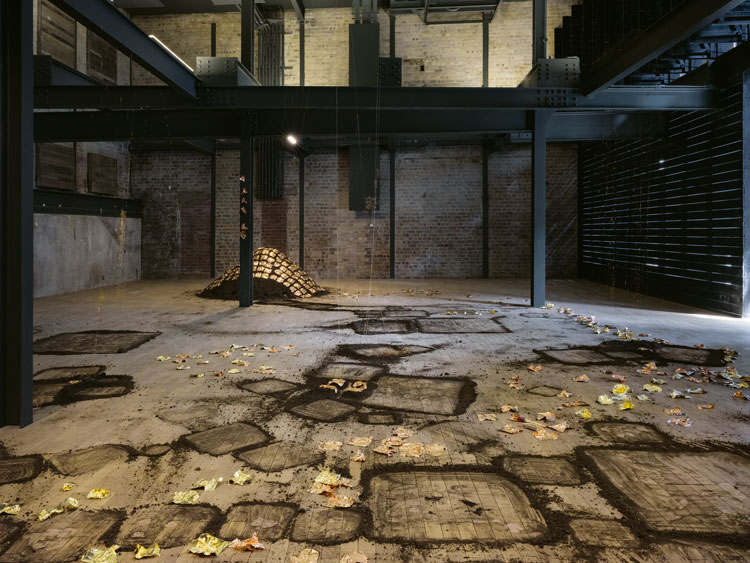
Karla Black. Waiver For Shade (detail), 2021. Thread, gold and copper leaf, Vaseline, earth, cosmetics, body moisturisers. Courtesy Galerie Gisela Capitain, Cologne and Modern Art, London. Photo: Tom Nolan.
Her creations respond to the spaces that frame them instinctively, viscerally, and as a provocation to the history of institutional authenticity and display. The newly refurbished and expanded Fruitmarket gives those instincts even greater rein now that the refurbished, white-walled galleries in the existing Fruitmarket space are joined by the stripped out, industrial qualities of the original market hall next door, into which the gallery now extends. To its rough, exposed brick walls and iron girders, Black has responded with piles of topsoil patterned with variegated gold leaf, squares of which also flutter, dipped and dabbled in dobs of cocoa butter, across the walls. The low lighting – mostly daylight filtered through wooden slatted screens – activate these textural extremes of gold shimmer and dark, earthy density to intoxicating effect.
Black came to art via a circuitous route – growing up in a working-class family in a sleepy town north of Glasgow she wasn’t taught art and had never encountered its contemporary evolution in the flesh until an older brother moved to Glasgow and started taking her to galleries and gigs. She trained as a journalist for a local newspaper, while making sculptures in her own studio in her spare time, and ultimately applied to Glasgow School of Art, where she studied from 1995-99, going on to gain an MPhil in art in organisational contexts (1999-2000) and an MFA (2002-04). She was nominated for a Turner prize in 2011 and has had solo exhibitions at Des Moines Art Center (2020), The Power Plant, Toronto (2018), the Institute of Contemporary Art, Philadelphia (2013), the Gallery of Modern Art Glasgow (2012) and the Migros Museum, Zurich (2009). Her works are held at the Scottish National Gallery of Modern Art, the Hammer Museum, Los Angeles and the Tate. She lives and works in Glasgow.
Veronica Simpson: Tell me about the work for the current show at the Fruitmarket. I can see you have been enjoying the greater variety of textures and spaces, with the addition of the warehouse-style gallery, which reminds me of the Arsenale in Venice.
Karla Black: Yes, Venice is the only other time I’ve shown work against bare brick. It’s hard to know what to do in that situation, even just to get it to show up. In the Arsenale, I went with the tone of that crumbling, pinky brick and I used chalk on sugar paper, almost mimicking those colours. Here, given that the floor is light (cement), I felt I needed to use something dark to get what I wanted out of it.
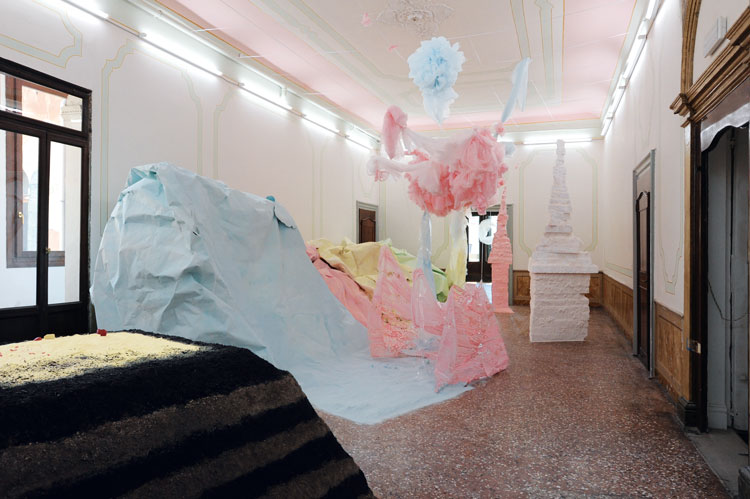
Karla Black, installation view, Palazzo Pisani, Scotland + Venice, 2011. Courtesy the artist and Galerie Gisela Capitain, Cologne. Photo: Gautier Deblonde.
In fact, I used earth in Venice. But the first time I used it was in 2009. In some ways, I feel that all the other materials I use, like the powder, is a substitute for earth. It comes from my childhood, all that working on a horizontal plane, scrabbling around on the ground - in dirt, grass and water. I still have a lot of memories that flash up of me doing that when I am working.
VS: You are taking a child’s-eye view?
KB: I guess people say that. They ask me about that. But it didn’t ever go away. I do understand that at one point I was a lot closer to the earth than I am now. But I don’t really understand all the life experience that makes (that perspective) go away in other people, because it didn’t go away for me … All my work is a kind of scrabbling about in the dirt. I don’t get how I could disconnect myself from the physical world. That would be really painful to me.
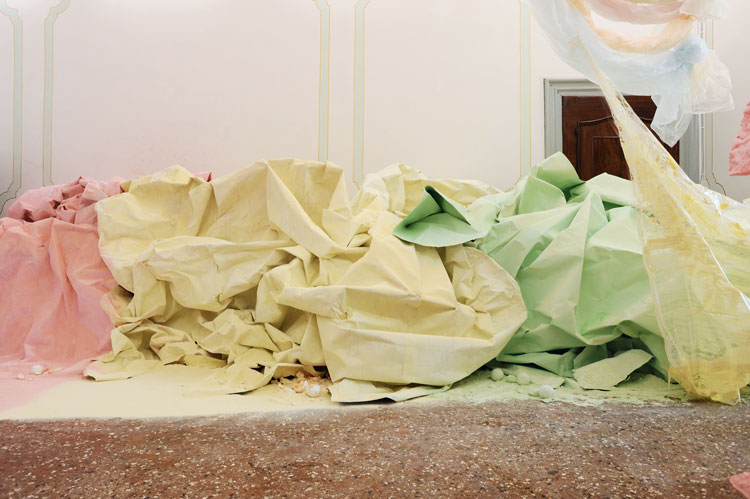
Karla Black At Fault (detail) 2011. Cellophane, paint, sellotape, plaster powder, powder paint, sugar paper, chalk, bath bombs, ribbon, wood. Installation view, Palazzo Pisani, Scotland + Venice, 2011. Courtesy the artist and Galerie Gisela Capitain, Cologne. Photo: Gautier Deblonde.
VS: The way you usually work is very much responding to a particular environment. What are the kinds of spaces you like? What are the qualities you are looking for - historic, modern, industrial, domestic, ruined?
KB: The most interesting thing to me is a white cube. That’s what I want: lots of daylight, white walls, dark floor. I like there to be a door in the middle, so you come in and the space is in front of you - you’re not coming in from the side - because vistas are really important to me. But, obviously, I can make something anywhere. Whatever the limits or the conditions are, the architecture or practicalities of the space, then I work very directly with that. But the easiest thing is for it to be completely blank.
VS: Is that because white walls are such a great backdrop for pigment and the fragile materials you work with?
KB: Yeah. I’m really into thinking about art history and the institution and the gallery not in terms of the connotations or any research, but just in terms of their physical actuality, of what they are. The history of artists making and showing work in those spaces, that’s what I would be much more interested in getting into. I would rather bring the difficulty than have it be difficult for me in terms of the space.
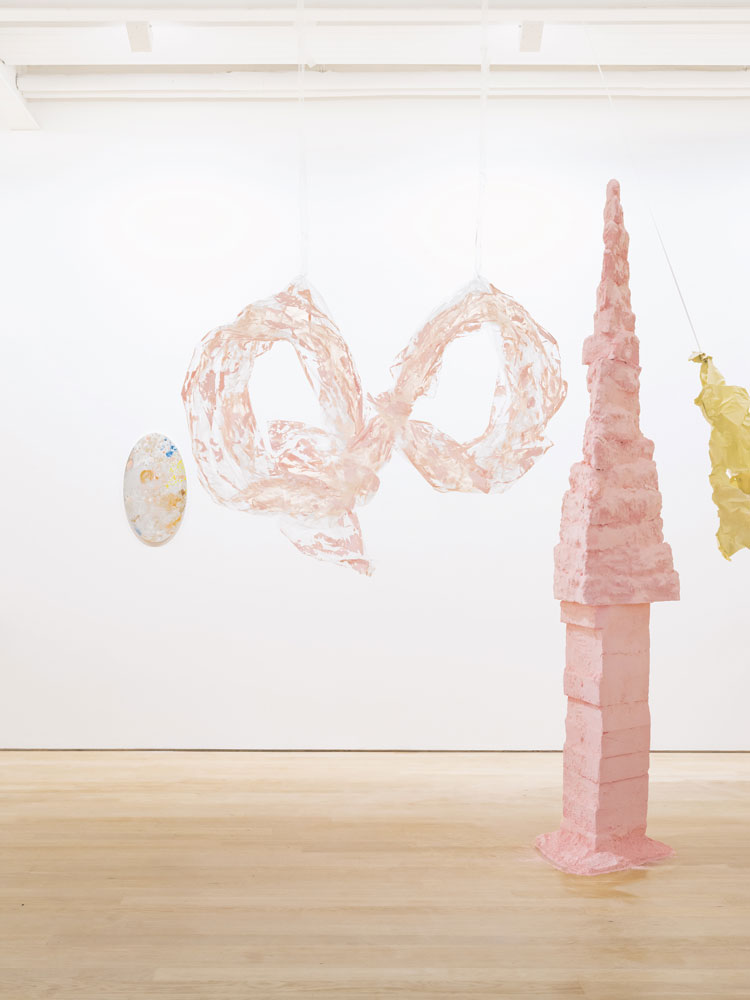
Karla Black. Left to right: Looking Glass number 16, 2021, mirror, glass paint, Courtesy Galerie Gisela Capitain, Cologne and Modern Art, London; Traps Take Practice, 2011, cellophane, paint, Sellotape, David and Indrė Roberts Collection; Don’t Depend, 2011, polystyrene, plaster, powder paint, plaster powder, paint, Collection of Nicoletta Fiorucci Russo De Li Galli, London; Opportunities For Girls, 2006/2021, sugar paper, chalk, ribbon, green concealer stick, nail varnish, Courtesy Galerie Gisela Capitain, Cologne and Modern Art, London.
VS: I was told recently that the original white cube gallery presentation was the exhibition for degenerate art that the Nazis hosted in Munich (Die Ausstellung “Entartete Kunst”, 1937). A blank, white setting was a way of denigrating and devaluing all of the work they had assembled. It’s amazing to me – given that history - that this has become the default setting for contemporary art.
KB: I like to still think of it like that, I suppose. Before that, what you would have would be the salon hang, where you would often have coloured walls, especially for painting: deep maroons, deep greens, quite low light. Then there are artists who, like Duchamp and the dadaists, were deconstructing the salon; he made it all string or wool and it’s like you can’t move in the space, much more like a happening or something. Even before that, when does art become separate from living to begin with? Just think about Greek and Roman times, with art being part of the wall, part of the floor; the paintings were on the actual stone. And even before that you would have cave art or aboriginal art on the land. It’s not separate. It’s a very weird thing to make it separate, like you cut a little chunk of it out and move it around rather than have it be part of the physical environment itself … To go from that to the white cube, I just think it’s weird. I suppose the point of Entartete Kunst and the way it was presented by the Nazis in a stark environment, so you see how degenerate it is, that’s pretty interesting. But so is the whole thing - that journey of it being taken as a specimen of human behaviour, then framed or putting a little fence round it, and then re-presenting it as art.
VS: Have you ever had a chance to create a permanent work as part of a structure?
KB: No, and I wouldn’t. I don’t make work outside. The gallery is the context for me. That’s where, in our “civilised society”, people say it’s supposed to be. But, hopefully, the act of doing that is to ram a messy, chaotic, difficult sort of creative moment into the institution and the gallery and the market and disrupt that sort of civilised society.
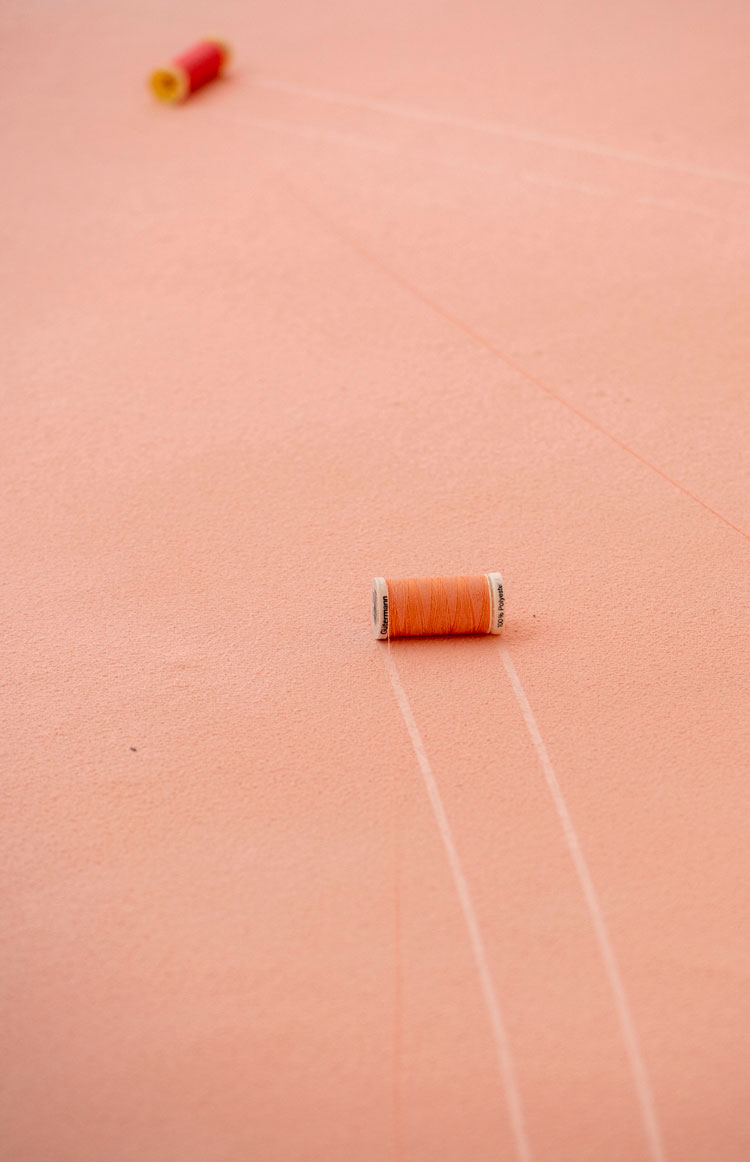
Karla Black. Punctuation is pretty popular: nobody wants to admit to much, (detail), 2008/2021. Plaster powder, powder paint, thread. Courtesy Galerie Gisela Capitain, Cologne and Modern Art, London.
Photo: Tom Nolan.
VS: Your work has a talent for making one intensely aware of the surroundings: the way you place the work, the materials you use and the textures and colours seem very much in dialogue with, or reflect the qualities of, the building, the context.
KB: I never think about architecture. I don’t know what people are thinking about when they think about architecture. I’m not interested in the architecture. It’s all about the physical props - I can hang something from that, or put something there. It’s a practical reality that existed before I got there. And I’m going to have to deal with it.
VS: But there is something particularly nice about the light in the Fruitmarket’s top gallery, the way that lightwell pours daylight into the room and over the big pink spill: the intensity of that light makes the powder spill hard to define – you can’t see the edges. It’s fascinating.
KB: Yes, it’s good to have all that daylight in there. Because it’s totally white, the walls turn pink – especially the right-hand one as you come up the stairwell. You almost can’t believe that wall is not pink. The whole room blushes, which I like.
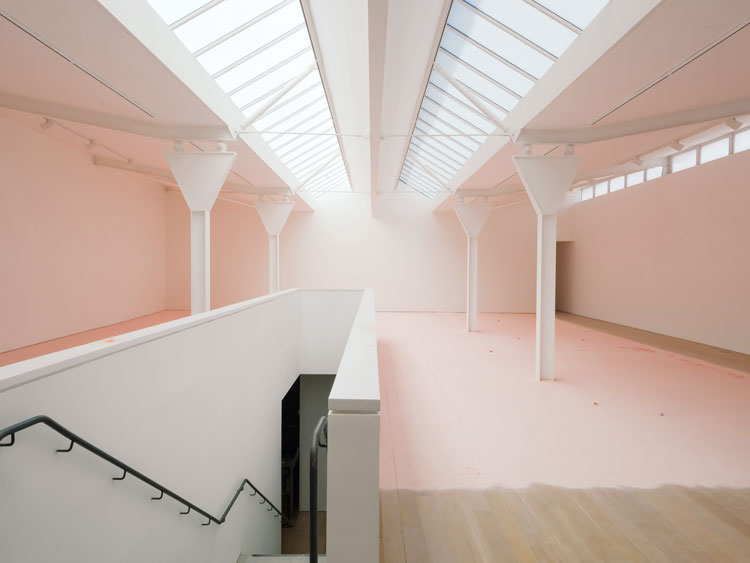
Karla Black: Sculptures (2001-2021) – Details for a Retrospective, installation view, Fruitmarket gallery. Courtesy Galerie Gisela Capitain, Cologne and Modern Art, London. Photo: Tom Nolan.
VS: You are well known for not differentiating between precious art materials and the mundane. I wondered about the degree to which we’ve all had to focus on the mundane in the last 18 months, and whether something has shifted for you - whether you feel more drawn to materials such as gold leaf after being immersed in the everyday?
KB: Well, I just don’t see the difference. I’ve never seen the difference. It’s a hierarchy of materials that’s just pretend. They’re all made of the same stuff. Plaster comes out of the ground. Pigment comes out of the ground, whether it’s eyeshadow or paint, they’re all natural materials. Also, I find it difficult to separate culture from nature. So that’s a similar thing. Take the distinction between natural and “manmade”: we’re an animal and we’re obviously part of nature, so everything we make is natural. I don’t see culture and nature as being separate things. There’s just a huge pretend around them. Because you go and buy your paints from an art supplier and you go to Boots for your eyeshadow or toothpaste (laughs), it’s not different. They all have unique material qualities and some are good at doing things that others can’t do. Like the sugar paper I use just takes the eyeshadow I use better. I wouldn’t use artist pigment for that because it’s heavy and the colours are horrible. If I want to use a powder on paper, I just use eyeshadow, because the colours are softer.
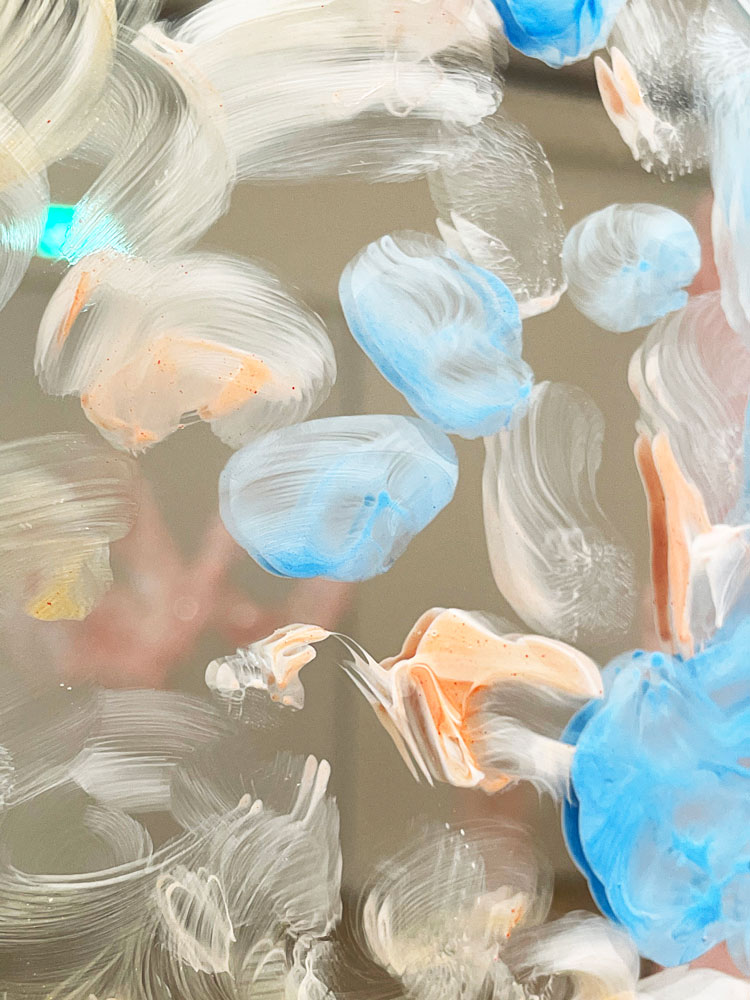
Karla Black. Looking Glass number 16, 2021 (detail). Mirror, glass paint. Courtesy the artist and Galerie Gisela Capitain, Cologne. Photo: Karla Black.
VS: Are you interested in the degree to which these materials are fetishised – the way makeup, for example, is put in these tiny little shiny pots and packaged to indicate that it is a luxury item when, as you say, it’s just pigment.
KB: I guess I would be on the other side of it. I try to say it is precious. It’s hard to put in words the level of attraction that I have to that kind of colour. I see colour as a material also. Say, for example, I go into Boots and see all the baby products. It’s not accidental (the colours they use). It’s like that for a reason. It’s about making money, but it’s other things as well. It’s the same with wedding dresses, baby shops, when I see these colours, it’s like you could scream with the joy of it, and how attracted I am to that, how joyful it makes me. But I know what it is, I know why it’s like that. What I always try to do in my work is say: “If you want to have that, here it is. It’s just pure colour and pure material, that’s what it is. All the other stuff is a trick. But you can have it. You can have it and completely possess it for yourself without the trick.” It’s so powerful. Like you said, it’s powerful when you go into a shop and there’s this beautiful lipstick or eyeshadow, a pigment in a beautiful colour and it sparkles and the packaging is amazing, it’s gold or it’s incredibly beautiful. But, obviously, there’s a disappointment maybe in the attempt to possess that. In the way that it’s presented to you – in a capitalist society, you can have it, but what do you have to give up? If you really want it, what is it you have to lose? You can take possession of it. But it already belongs to us. And it’s just colour and material.
I think abstraction is quite a political stance, it’s about freedom and disengagement from things like language, and all those things are so bound up in that.
VS: I confess, I used to be a sucker for luxury makeup. In my 20s and 30s, when I got a chunk of money, I would go to the department store and feast my eyes and senses on those products, treasuring the one or two I would take home with me. But, really, what you are seduced by is the whole presentation, because you want them all. The real luxury would be to take home the whole Chanel counter.
KB: (laughs) Yeah, that’s what I’m trying to do. I want people to have it all. I am not denigrating it, I love it. But there’s also something really important about what it means to you, what these things say about status. I never really worked out what it was. But when I had no status – I’m not saying I have any now – but when I was in my early 20s, living in shared flats infested with mice, with no money but still trying to make work, one thing that would always make me feel so much better is when I would buy the biggest bottles of Clinique products I could afford and then I’d lay them all out in a line at home. That felt like … I don’t know what it was, but it felt important. It built up my sense of status. Having those nice things is about status, but I wouldn’t want to talk about it in a negative way. People knock you if you spend money on that, as if you’re shallow. It’s really problematic. But I think it’s amazing - makeup and buying makeup. It’s really exciting and celebratory, but, at the same time, I’m trying to take that thing and say it is completely mine, it is completely yours. Of course, we love it and it belongs to us.
VS: It’s the promise of transformation, isn’t it?
KB: Yes, and it was really annoying maybe 10 years ago when people would ask me: “Do you use these materials because you’re a woman?” I know them because I’ve used them, but I know men who have used them. For example, the way they use makeup on RuPaul’s Drag Race is incredible.
VS: Absolutely, and it has so much traction, that idea of self-transformation and play - the way the drag queens use it is much more playful. It takes that idea of transformation to a new level, whereas women have used it traditionally to make themselves pretty.
KB: Or to cover up or make themselves seem younger. It’s problematic … But I’m interested in the way that makeup is supposed to have a civilising influence – like the idea that having a wall painted white is a civilising aspect, it’s clean, it’s smooth. That’s what painting and sculpture are used for, too: to elevate, to civilise, to cover up. When, in fact, it is all – we are all - quite visceral and of the earth.
• Karla Black: Sculptures (2001-2021) – Details for a Retrospective is at Fruitmarket, Edinburgh, 7 July – 24 October 2021.